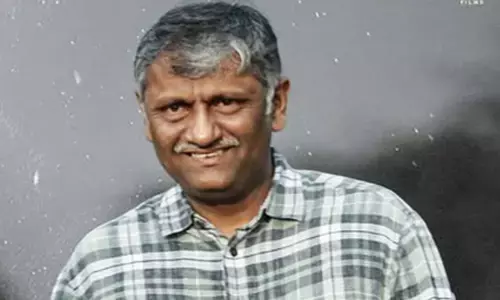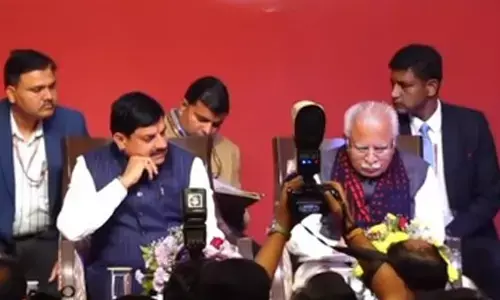Better implementation of RUSA

Better Implementation of RUSA, Rastriya Ucchatar Siksha Abhiyan, Chukka Ramaiah. The implementation of “Rastriya Ucchatar Siksha Abhiyan” plan (RUSA) to strengthen higher education through Ministry of Human Resource Development (MHRD) of Government of India as a centrally-sponsored scheme all over the country is a welcome measure.
Keeping Andhra Pradesh’s experiences in mind, I strongly suggest that the compulsion of matching grant as an essential condition for the successful implementation of the scheme be waived.
.jpg) The implementation of “Rastriya Ucchatar Siksha Abhiyan” plan (RUSA) to strengthen higher education through Ministry of Human Resource Development (MHRD) of Government of India as a centrally-sponsored scheme all over the country is a welcome measure.
The implementation of “Rastriya Ucchatar Siksha Abhiyan” plan (RUSA) to strengthen higher education through Ministry of Human Resource Development (MHRD) of Government of India as a centrally-sponsored scheme all over the country is a welcome measure.The RUSA rightly identified the access, equity and quality in higher education as the principle objectives for improvement in this scheme. Our Gross Enrollment Ratio (GER) of the students in the relevant age group of 18-23 years is 18.8% and the world average is 29% (as of year 2010). The objective of RUSA to increase the Gross Enrollment Ratio (GER) to 30% by the year 2020 (set by Central Government) is laudable. This centrally-sponsored scheme aims to spread over two plan periods (12th & 13th five-year plans) and focus on state higher educational institutions.
The key aspects of RUSA are to provide opportunities for higher education to all who deserve and desire higher education (access), fair access to the poor and the socially disadvantaged groups to higher education (equity), and providing knowledge of the highest standards available in education to help the students to enhance their skills and other human resource capabilities (quality).
Keeping in view the recommendations of the planning commission, the Central Government has undertaken this ambitious “Umbrella Scheme”. The scheme is based on the condition that State Government must contribute its share of 35% of the total cost to be eligible for 65% of Central assistance. An undertaking is to be given by the State Government to this extent. What happened in Andhra Pradesh during the implementation of “Sarva Siksha Abhiyan” is still fresh in my memory.
Nearly 800 crores of rupees went unutilised for want of State Government’s matching grant. While the neighboring State of Tamilnadu could get Rs 1000 crore from the Centre to strengthen student enrollment at primary education, Andhra Pradesh failed miserably.
Even the additional hundred crore rupees Tamilnadu Government received from the Centre for ‘Kitchen Construction’ in support of Midday meal scheme, we have failed to receive because of administrative lapses. Higher education needs to be viewed as a long-term social investment but not as expenditure. Keeping Andhra Pradesh’s experiences in mind, I strongly suggest that the compulsion of matching grant as an essential condition for the successful implementation of the scheme be waived.
Research is an important element for the quality of any university. Government initiative is imperative to improve the standard of research in Universities with heavy investment in building research infrastructure. RUSA’s assistance for research is a significant measure in the scheme.
The Universities must attract money from the industry and business houses for the sustainability of research and development. Some Universities and nationally reputed science institutes/laboratories like CCMB, NIN must be roped in with special responsibility to pursue globally competent research work. Industries, such as IT industry, pharma industry, pesticide industry may be levied higher education cess as they are the ultimate beneficiaries from the research output of the universities.
This amount may be siphoned back to universities to augment research base. Huge and endowments can be tapped from alumni if universities and colleges workout seriously. The state government may consider such aspects for mobilizing funds to strengthen research/universities.
The RUSA Document rightly pointed out an alarming trend that India’s global share of scientific publication is 3.5% while China’s share is 21.1% during 2002-2007. It further stated that China has surged ahead rapidly in terms of its research output and is almost rivaling the USA. Our weakness in promoting world class research is made explicitly clear. The data on various parameters pertaining to higher education like student-teacher ratio, faculty vacancies exposes our shortcomings very clearly.
At the national level the scheme will be implemented by the four bodies namely RUSA Mission Authority, Project Approval Board, Technical Support Group and the Project Directorate (in MHRD) constituted by MHRD for overall guidance, policy decisions, project management and coordination. RUSA will work in the states through the State Higher Education Councils (SHEC). The SHEC is expected to perform planning, monitoring & evaluation, quality assurance and academic functions besides advisory and funding functions.
To ensure quality and excellence in higher education, adequate number of good faculty in institutions is required. Besides the low number of sanctioned faculty positions, faculty vacancies even in sanctioned posts are not being filled which is undisputedly a serious problem. Dhande Committee report has identified the vacancy positions in Universities or Colleges as 40% as of 2008.
The issue is much more challenging in the rural institutions and backward areas. Faculty shortage creates extremely serious problems in the teaching-learning process besides research or curriculum development. In most affiliated colleges, faculty strength is grossly inadequate and mostly filled with contract faculty or part-time teachers.
This does not facilitate quality enhancement and continuity. Even after identifying the malady, RUSA’s permission to states to allow 15% of the faculty positions to remain vacant in the coming ten years is strange and a compromise on quality. This dilution will mostly, as usual, affect the rural area colleges. Besides, the student-teacher ratio of 24:1 in India is very unreasonable whereas the same stands at 9.5:1 in Sweden, 13.6:1 in the USA, 18:1 in the UK, 16.8:1 in China and 18.01:1 in Russia. This will impact on quality. This must be ideally 15:1 if we are serious of quality.
RUSA aims to function on the principle of performance-based funding. It focuses on equity based development and improvement in teaching-learning quality and research. Funding will be available to government aided institutions also on 50:50 percent for certain permitted activities subject to certain pre-conditions.
To be eligible for RUSA funding, the state shall fulfill certain prerequisites. Creation of State Council of higher education (SCHE), creation of accreditation agencies, preparation of state perspective plans, Governance reforms, filling faculty positions etc. An initial amount will be provided to state Governments for meeting these requirements.
It is the hope that RUSA comes up to the expectations of the common man in meeting the challenges of providing access, equity and excellence at global level to our universities and colleges. It is also hoped that it encourages courses in pure sciences. Pure Sciences have been relegated to the back seat and are not getting the required impetus as the professional courses do. It is likely to create a big vacuum in the area of sciences in the future. This problem has to be addressed at the earliest.
Next Story
















